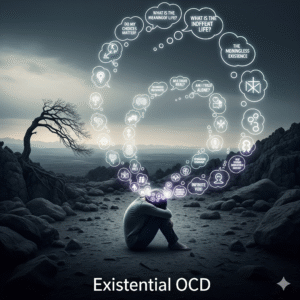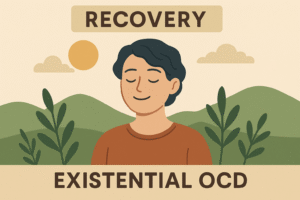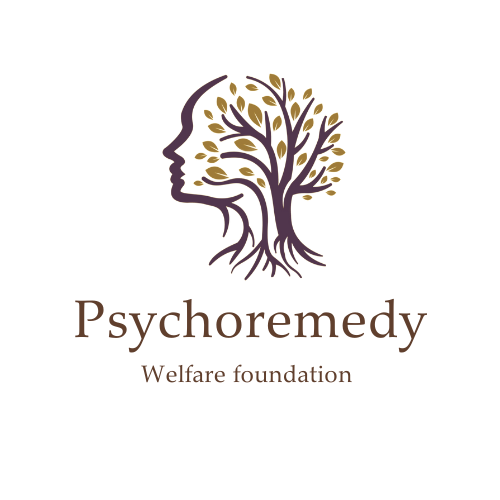Understanding Existential OCD: When Big Questions Get Stuck
Have you ever been trapped by looping, anxious questions about the nature of reality or the meaning of life? If these philosophical thoughts disrupt your daily peace, you may be experiencing Existential OCD. This is not just “deep thinking”; it’s a treatable condition where the brain gets stuck on unanswerable questions. This guide will walk you through the symptoms, professional treatments, and the steps you can take to break free.

What is Existential OCD?
Existential OCD is a form of Obsessive-Compulsive Disorder where a person experiences intrusive, unwanted thoughts (obsessions) about profound philosophical topics, leading to repetitive behaviors or mental acts (compulsions) to reduce the resulting anxiety.
Unlike general philosophical curiosity, this condition is not about intellectual exploration. It’s about a brain circuit getting “stuck,” treating unanswerable questions about life, death, and reality as immediate, solvable threats. The core problem isn’t the question but the brain’s intolerance of uncertainty and the compulsive need to find a 100% certain answer, which is impossible.
Symptoms: The Obsession-Compulsion Cycle
The symptoms of Existential OCD are divided into two parts that feed each other in a vicious cycle.
Common Obsessions (Intrusive Thoughts)
- Persistent doubts about the nature of reality (e.g., “What if this is all a dream or simulation?”).
- Intrusive thoughts about the meaning or pointlessness of life.
- Overwhelming fear and preoccupation with the concept of death or infinity.
- Constant questioning of one’s own existence or sense of self (“Why am I ‘me’ and not someone else?”).
- Feeling disconnected from reality (derealization) or from oneself (depersonalization).
Common Compulsions (Rituals & Safety Behaviours)
- Endless Research: Spending hours on the internet, in books, or watching videos trying to find a definitive answer to a philosophical question.
- Mental Review: Constantly replaying arguments in your head, trying to construct a perfect, unbreakable logic to feel safe.
- Reassurance Seeking: Repeatedly asking friends or family if they think life has a point or if reality feels real to them.
- “Reality Checking”: Staring at objects, pinching oneself, or trying to “feel” connected to the world to prove it’s real.
- Avoidance: Steering clear of movies, conversations, or books that might trigger existential thoughts.
Healing from Existential OCD: Moving Forward with Meaning
Self-help is a great starting point, but for lasting recovery, evidence-based therapies are considered the gold standard.
- Exposure and Response Prevention (ERP): This is the leading treatment for all forms of OCD. A therapist guides you in gradually facing your obsessive thoughts and the uncertainty they bring (exposure) without performing the compulsions that provide temporary relief (response prevention). This process retrains your brain to learn that uncertainty is not a threat, and the anxiety naturally decreases over time through a process called habituation.
- Acceptance and Commitment Therapy (ACT): ACT teaches you to stop struggling with your thoughts. Instead of trying to eliminate them, you learn to notice them, accept their presence without getting “fused” to them, and commit to taking action based on your personal values. For someone with Existential OCD, this means learning to live a meaningful life even with the presence of unanswered questions.
- Medication: Selective Serotonin Re-uptake Inhibitors (SSRIs) are often prescribed alongside therapy. They can help regulate the brain circuitry involved in OCD, reducing the intensity of obsessions and compulsions, which makes the therapeutic work in ERP and ACT more effective.
“These strategies are often used alongside other mindfulness techniques for anxiety.”
Anxiety vs Depression: Clear Signs, Overlap & Proven Relief

How to Manage Existential OCD: A 5-Step Self-Help Guide
You can begin to break the cycle of Existential OCD with these practical strategies. The goal is not to answer the big questions but to change your relationship with them.
1. Label the Thought, Don’t Debate It
When an obsessive thought appears, don’t treat it as a profound philosophical emergency. Instead, label it for what it is.
- What to do: Say to yourself, “I am having an obsessive thought about reality,” or “This is my Existential OCD acting up.”
- Why it works: Labeling creates a small but crucial space between you and the thought. It reminds you that this is a symptom of a condition, not a factual crisis.
2. Drop the Mental Tug-of-War
Your compulsions (researching, ruminating) are like pulling on a rope in a tug-of-war with your anxiety. The only way to win is to drop the rope.
- What to do: Make a conscious choice to not engage. Allow the thought to be there without trying to solve it, analyze it, or push it away. Acknowledge it, then redirect your focus to something in the present moment.
- Why it works: This is the “response prevention” part of ERP. You’re teaching your brain that you don’t need to perform a ritual to survive the anxiety. It will feel very uncomfortable at first, but the anxiety will eventually peak and subside on its own.
3. Practice Welcoming Uncertainty
OCD thrives on your demand for 100% certainty. Your recovery depends on learning to live with uncertainty.
- What to do: When your brain screams for an answer, respond with a calm, non-committal phrase. “Maybe reality is real, maybe it isn’t. I’m choosing to live it anyway.” Or simply, “I can’t know for sure, and I’m learning to be okay with that.”
- Why it works: This directly challenges the core fear of OCD. By willingly accepting “maybe,” you strip the obsession of its power.
4. Ground Yourself in Your Senses
Existential OCD traps you in the abstract world of your mind. The fastest way out is to anchor yourself in the physical world.
- What to do: Use the 5-4-3-2-1 Grounding Technique. Pause and name:
- 5 things you can see.
- 4 things you can feel (the chair beneath you, the fabric of your clothes).
- 3 things you can hear.
- 2 things you can smell.
- 1 thing you can taste.
- Why it works: This technique forces a shift in your brain’s attention from abstract rumination to present-moment sensory processing, providing an immediate pattern interrupt.
5. Take Valued Action
If OCD asks, “What’s the point?”, the best answer isn’t a thought; it’s an action.
- What to do: Identify what is important to you (your values), such as kindness, connection, creativity, or learning. Then, take one small action based on that value. Call a friend, draw for five minutes, or read a chapter of a book.
- Why it works: This is a core principle of ACT. You create meaning through your actions. By acting on your values, you prove to yourself and your brain that you can live a purposeful life, even in the absence of cosmic certainty.
For finding a qualified specialist
International OCD Foundation (IOCDF)
Written by: Dr. Sadia Habib
Reviewed : Psychoremedy, Pakistan Psychology Today


